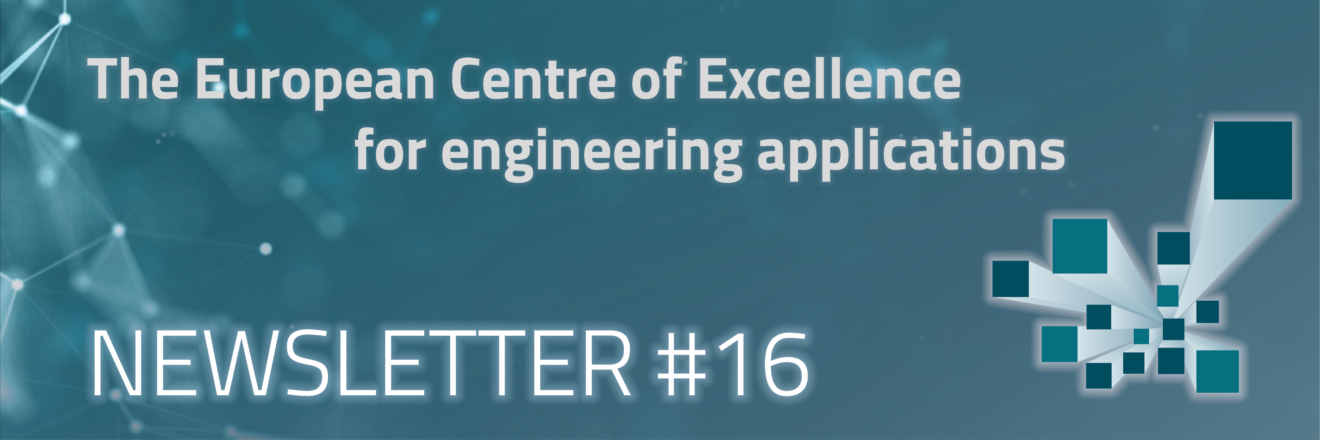|
|
|
|

|
Content
|
|
a) HPC for industry - driving innovation in Manufacturing
|
|
b) HPC for industry - driving innovation in Aeronautics
|
|
c) Blog article: Engaging Supercomputer Users to Optimize Workloads and Reduce Waste
|
3. Podcast: Data Management Solutions for Industry
|
|
|
|
|
|
1. Welcome
|
Just before the summer holidays start, we'd like to share our latest news with you. Our technical work packages have put in place mechanisms that ensure progress on the EXCELLERAT use cases. Meanwhile, our service portal is being restructured, and the first communication activities have taken place. For instance, our latest podcast episode we recorded with our project partner SSC-Services GmbH, focused on data management for industry.
|
In this issue of our newsletter, you can find out more about our latest blog articles, and get information about upcoming (training) events.
|
I hope you enjoy reading our newsletter, have a great summer time, and continue to follow our updates!
|
|
EXCELLERAT P2 Project Coordinator
|
|
|
|
2. a) Blog article: HPC for industry - driving innovation in Manufacturing
|
|
Embracing HPC in industry to fulfil the demands for processing highly complex tasks and large volumes of data in real-time could result in significant business benefits such as reducing costs for product or service development, considerable human resources costs savings, speed up the development process and decrease time to market. Furthermore, supercomputers can process vast amounts of data in a short amount of time, allowing companies to analyse large datasets and make better-informed decisions quickly.This blog article reflects on the benefits of HPC for manufacturing.
|
|
2. b) Blog article: HPC for industry - driving innovation in Aeronautics
|
|
HPC enables companies operating in any industrial sector to become more innovative, more productive and maintain a competitive edge. But above all, with the help of cutting-edge technologies such as cloud supercomputing, artificial intelligence, machine learning and big data analysis, companies can develop products and services with a higher added value. Learn more about how HPC can be beneficial for the aeronautics sector in this blog article.
|
|
2. c) Blog article: Engaging Supercomputer Users to Optimize Workloads and Reduce Waste
|

|
|
In a new blog post, we want to bring attention to the central role of supercomputer users in the mitigation of computational waste. In a nutshell, users are not aware of wasteful behaviors. Therefore, after a brief recall of what running a supercomputer means, we will introduce new metrics for measuring computational waste, then we will describe the two main waste sources: understayers jobs and overstayer jobs. Finally we will show how we can engage users in this quest for better and cleaner workloads.
|
|
|
|
3. Podcast: Data Management Solutions for Industry
|

|
|
We have produced the sixth episode of the HPC podcast powered by EXCELLERAT. This time, the spotlight is on our project partner SSC-Services GmbH from Böblingen, Germany. The focus of this episode is the challenges industry faces with respect to HPC usage from the data management view, in particular small and medium-sized enterprises. SSC-Services developed a data exchange and workflow portal in EXCELLERAT project phase 1, which is now being built on. Listen to the episode on Spotify.
|
|
|
|
4. Further news & events
|
We have launched a YouTube channel – subscribe for multimedia updates.
|
|
Training course: Scientific Visualization with COVISE and Vistle
|
|
(9-10 October 2023, HLRS in Stuttgart, Germany)
|
This on-site course is targeted at researchers with basic knowledge in numerical simulation, who would like to learn how to visualize their simulation results on the desktop but also in Augmented Reality and Virtual Environments. The two-day workshop gives a short overview over scientific visualization in general, followed by a hands-on introduction to 3D desktop visualization with VISTLE and COVISE. Participants will further learn how to build interactive 3D Models for Virtual Environments and how to set up an Augmented Reality visualization. Register now
|
|
Self-paced course: Approaches to analysing time-series data
|
|
Tourist destination managers, service providers, and researchers want to better understand traffic flows: what impact traffic flows have, when do traffic peaks occur, what are the seasonal effects, which areas are more / less congested with tourists, how do weather, holidays and other events affect this behaviour. With the help of data analysis and forecasts, they can prepare for periods of increased visits, as well as adjust marketing activities, service offerings, or resources allocation. In this tutorial we look at a real-world dataset consisting of traffic counters on Slovenian roads, provided by the Slovenian Road Network (DARS), and its application to the questions above. Get access to the tutorial through our Service Portal.
|
|
|
|
|
|

|
|
Funded by the European Union. This work has received funding from the European High Performance Computing Joint Undertaking (JU) and Germany, Italy, Slovenia, Spain, Sweden, and France under grant agreement No 101092621.
|
Höchstleistungsrechenzentrum Stuttgart (HLRS) | Nobelstraße 19
|
|
70569 Stuttgart | Germany
|
|
|
|
|
|
|